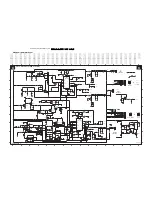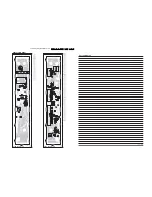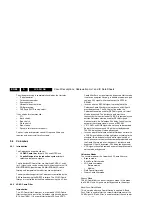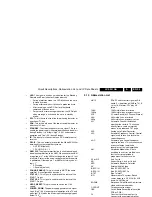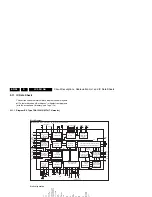
Circuit Descriptions, Abbreviation List, and IC Data Sheets
EN 86
LC4.9U AA
9.
Table 9-1 Models and picture quality
Figure 9-2 Block diagram of the internal building blocks
The Genesis GM1501 Malibu Scaler IC can receive two video
input signals: SDTV (directly from Hercules or via Columbus),
DVI (from an external DVI source), or PC (from external
computer).
After the video processing, the digital data is sent via a Low
Voltage Differential Signalling bus to the LCD panel. LVDS is
used to improve data speed and to reduce EMI significantly.
There are two I
2
C lines and two interrupt and communication
lines (TV_IRQ and TV_SC_COM) for the Scaler control. The
Scaler communicates with the Hercules as a slave device. To
avoid buffer overflow at the Scaler side, the TV_SC_COM line
provides the necessary hardware flow control. To allow bi-
directional communication, the Scaler can initiate a service
interrupt-request to the Hercules via the TV_IRQ line.
The Hercules, and EEPROM are supplied with 3.3 V, which is
also present during STANDBY.
The EEPROM, or NVM (Non Volatile Memory) is used to store
the settings.
The sound part is built up around the Hercules. The Source
Selection, Decoding and Processing are all done by the
Hercules.
Power supply input are several DC voltages coming from a
supply panel.
9.3
Input/Output
The I/O is divided over two parts: Rear I/O and Side I/O. The
rear has two AV inputs with CVBS, Y/C and YUV, a PC (VGA)
input, and an HDMI input. The side has a CVBS and Y/C
(SVHS) input.
The selection of the external I/O's is controlled by the Hercules.
AV1 / CVI-1
: The input of AV1 / CVI-1 is CVBS + YUV + L/R.
AV2
: The input of AV2 is Y/C + CVBS + L/R.
PC-VGA/CVI-2:
This input is directly going to the Scaler IC.
See paragraph “Video: Scaler Part”.
HDMI in / PC-D:
This input is directly going to the Scaler IC.
See paragraph “Video: Scaler Part”.
9.4
Tuner and IF
A Philips UV1316E/1318SD/TEDE9 Tuner is used in the TV
board. The SIF signals are decoded by the Hercules. Tuning is
done via I
2
C.
9.4.1
Video IF Amplifier
The IF-filter is integrated in a SAW (Surface Acoustic Wave)
filter. One for filtering IF-video (1104, in some models: 1105)
and one for IF-audio (1106). The type of these filters depends
on the standard(s) that has/have to be received.
The output of the tuner is controlled via an IF-amplifier with
AGC-control. This is a voltage feedback from pin 31 of the
Hercules to pin 1 of the tuner. The AGC-detector operates on
top sync and top white level. AGC take-over point is adjusted
via the service alignment mode ’Tuner' - 'AGC’. If there is too
much noise in the picture, then it could be that the AGC setting
is wrong. The AGC-setting could also be mis-aligned if the
picture deforms with perfect signal; the IF-amplifier amplifies
too much.
Model
Picture quality
42PF7320/28
Pixel Plus
N.a.
Digital Crystal Clear
N.a.
Crystal Clear
HERCULES
PIXEL PLUS
ADC
CVBS
Pb, Pr
COLUMBUS
SCALER
EPLD
LVDS
HERCULES
DIGITAL
CRYSTAL CLEAR
ADC
CVBS
Pb, Pr
COLUMBUS
SCALER
LVDS
HERCULES
CRYSTAL CLEAR
R, G, B
SCALER
LVDS
F_15270_008.eps
240505



